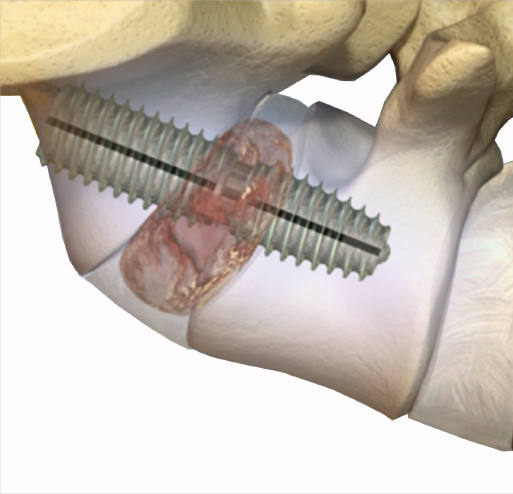
AxiaLIF+ is a minimally invasive L5-S1 spinal fusion procedure that stabilizes the foundation of your spine.
The AxiaLIF+ procedure provides doctors with an additional approach to spine fusion. The procedure gives surgeons the ability to stabilize painful joints in the spine through very small incisions. The procedure is designed to spare the muscles and supporting soft-tissues of the spine, thus minimizing surgical trauma and post-operative pain.[1, 2, 4]
Small Incision Size
AxiaLIF+ utilizes a 2-3cm incision near the tailbone, minimizing damage to muscles and tissues around the spine.[1, 2, 4]
Quicker Recovery
When compared to similar L5-S1 spinal fusion procedures, AxiaLIF+ frequently shortened recovery times for patients.[5]
High Fusion Rate
AxiaLIF+ demonstrates favorable fusion rate for spinal fusion at the L5-S1 joint,[1, 5, 6, 7, 8, 9] a success rate comparable to alternative methods.
AxiaLIF+ Illustrated Guide

Step 1: Degenerative disc and improper disc height before the AxiaLIF procedure

Step 2: Access to the diseased disc is obtained

Step 3: Center of the diseased disc is removed

Step 4: Bone growth material is inserted in place of the diseased disc

Step 5: Lost disc height is restored and the spine is stabilized. Further stabilized with posterior fixation such as Keystone MIS pedicle screws or Vectre facet screws
AxiaLIF+ FAQs
Who are the patients AxiaLIF can be used for?
The AxiaLIF Plus system is indicated for patients with degenerative disc disease, failed previous fusion (pseudoarthrosis), slight slippage of one vertebral body over the other (grade 1 spondylolisthesis) and spinal canal narrowing (spinal stenosis). Your doctor will assess your case and determine whether you might be a candidate for AxiaLIF.
I read what people are saying about AxiaLIF Plus. Do all AxiaLIF Plus Patients do so well?
In two separate AxiaLIF studies, patients experienced a reduction in pain. However, results do vary from patient to patient.
AxiaLIF Plus, like any minimally invasive surgery, involves small incisions and minimal muscle damage. As a result, some patients may experience less post-operative pain associated with the approach compared to traditional open procedures. Each patient’s results are unique and will be discussed through your surgeon.
How many scars will I have from this procedure? How big will they be?
The AxiaLIF Plus portion of the procedure carries only one scar which is typically about one-inch long and located next to your tailbone. You will have further stabilization in your spine that would require one or more small vertical scars down each side of your back. Ask your doctor about posterior instrumentation such as facet screws or pedicle screws which further stabilize your spine after the AxiaLIF Plus procedure is performed.
What are the risks of this procedure?
All surgery carries risk. The risk of bleeding, complications from the anesthesia, infection – both local and systemic, and the risk of injury to healthy tissue is present for all types of surgery. For AxiaLIF surgery, the surgeon will be approaching your spine from an incision near your tailbone and may inadvertently damage the bowel, bone or blood vessels in the area. The risk of bowel injury has been reported to be 0.6% in a peer reviewed journal article.[2] The device is implanted in the bones of your anterior spine and it may move, break, or irritate nearby soft tissues. The device must be used with additional screws in your back that may cause other problems. Finally, surgery is not always effective in promoting the bones to fuse and your back pain may continue or get worse after surgery. You should discuss these risks with your doctor.
What are the risks of this procedure?
All surgery carries risk. The risk of bleeding, complications from the anesthesia, infection – both local and systemic, and the risk of injury to healthy tissue is present for all types of surgery. For AxiaLIF surgery, the surgeon will be approaching your spine from an incision near your tailbone and may inadvertently damage the bowel, bone or blood vessels in the area. The risk of bowel injury has been reported to be 0.6% in a peer reviewed journal article.[2] The device is implanted in the bones of your anterior spine and it may move, break, or irritate nearby soft tissues. The device must be used with additional screws in your back that may cause other problems. Finally, surgery is not always effective in promoting the bones to fuse and your back pain may continue or get worse after surgery. You should discuss these risks with your doctor.
How much pain should I expect after the procedure is performed?
The amount of pain that a patient will experience immediately following the procedure can vary. As with most spine surgeries, this discomfort will tend to diminish over time. In two separate patient studies[1,7] patients experienced a reduction in pain over time.
How long will I have to stay in the hospital after surgery?
AxiaLIF Plus length of stay may be as short as one to two days, but is dependent on your individual surgical outcome and your surgeon’s medical opinion.
How long will it take to get back to work?
Only your doctor can determine when you should resume your regular work activities.
How long will it take to return to my daily activities?
Only your doctor can determine when you should resume your regular daily activities.
With any surgery, there are potential risks of complications. We’ve collected information that patients should understand before undergoing procedures utilizing TranS1 devices. Please view the Indications for Use for Usage and Risks associated with TranS1 procedures. Talk to your doctor to learn more.
Spine Conditions
AxiaLIF Clinical Publications
Spine Surgery Glossary


